UK Consumer Loyalty: A SAFe Case Study of Sainsbury's Branding
VerifiedAdded on 2023/06/11
|15
|3525
|369
Project
AI Summary
This project investigates consumer loyalty to Sainsbury's house branding in the UK retail supermarket sector, employing a Suitability, Acceptability, and Feasibility (SAFe) framework. The study aims to understand the implications of house branding, analyze Sainsbury's branding strategies for competitive advantage, explore the concepts and practices adopted by Sainsbury's, identify challenges in delivering house brands, and determine the benefits for suppliers, retailers, and customers. The research methodology involves both primary data collected from interviews with senior executives and secondary data gathered from various sources. Data analysis reveals the significant role of consumers in enhancing supermarket own brands and the importance of customer loyalty in the house branding process. The findings highlight the interconnectedness of customers and the retail supermarket in driving economic development within the business.
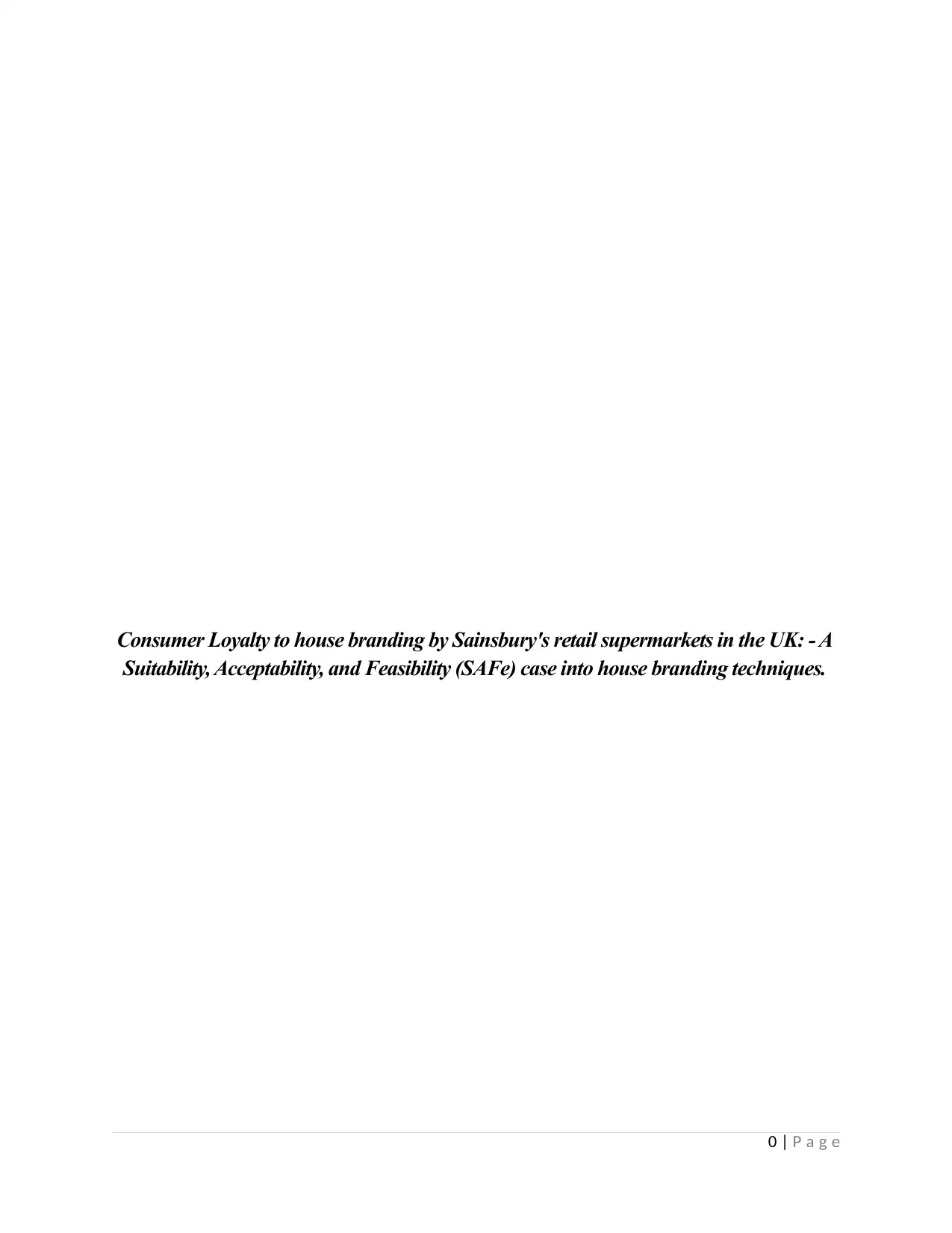
Consumer Loyalty to house branding by Sainsbury's retail supermarkets in the UK: - A
Suitability, Acceptability, and Feasibility (SAFe) case into house branding techniques.
0 | P a g e
Suitability, Acceptability, and Feasibility (SAFe) case into house branding techniques.
0 | P a g e
Paraphrase This Document
Need a fresh take? Get an instant paraphrase of this document with our AI Paraphraser
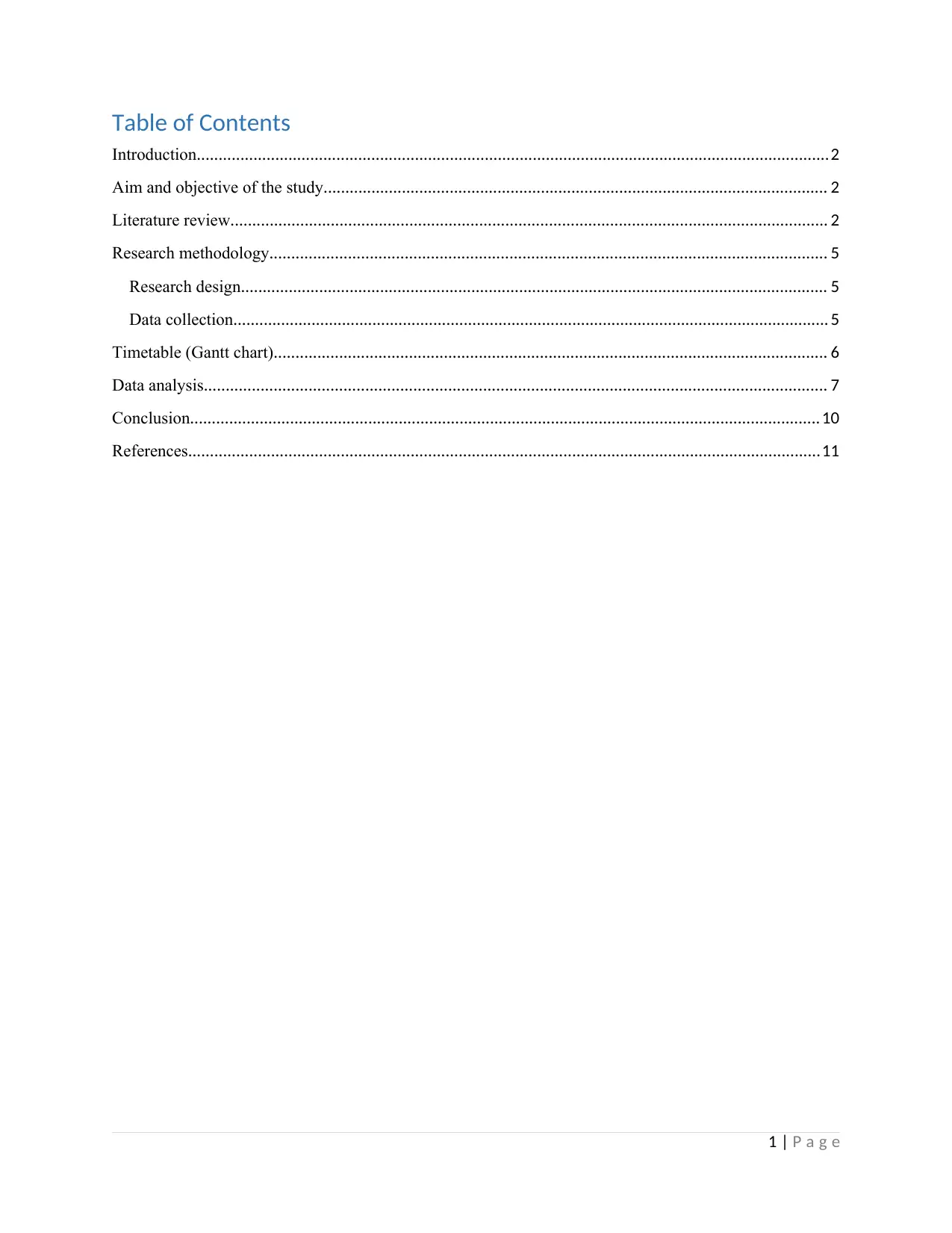
Table of Contents
Introduction.................................................................................................................................................2
Aim and objective of the study.................................................................................................................... 2
Literature review......................................................................................................................................... 2
Research methodology................................................................................................................................ 5
Research design....................................................................................................................................... 5
Data collection......................................................................................................................................... 5
Timetable (Gantt chart)............................................................................................................................... 6
Data analysis............................................................................................................................................... 7
Conclusion................................................................................................................................................. 10
References.................................................................................................................................................11
1 | P a g e
Introduction.................................................................................................................................................2
Aim and objective of the study.................................................................................................................... 2
Literature review......................................................................................................................................... 2
Research methodology................................................................................................................................ 5
Research design....................................................................................................................................... 5
Data collection......................................................................................................................................... 5
Timetable (Gantt chart)............................................................................................................................... 6
Data analysis............................................................................................................................................... 7
Conclusion................................................................................................................................................. 10
References.................................................................................................................................................11
1 | P a g e
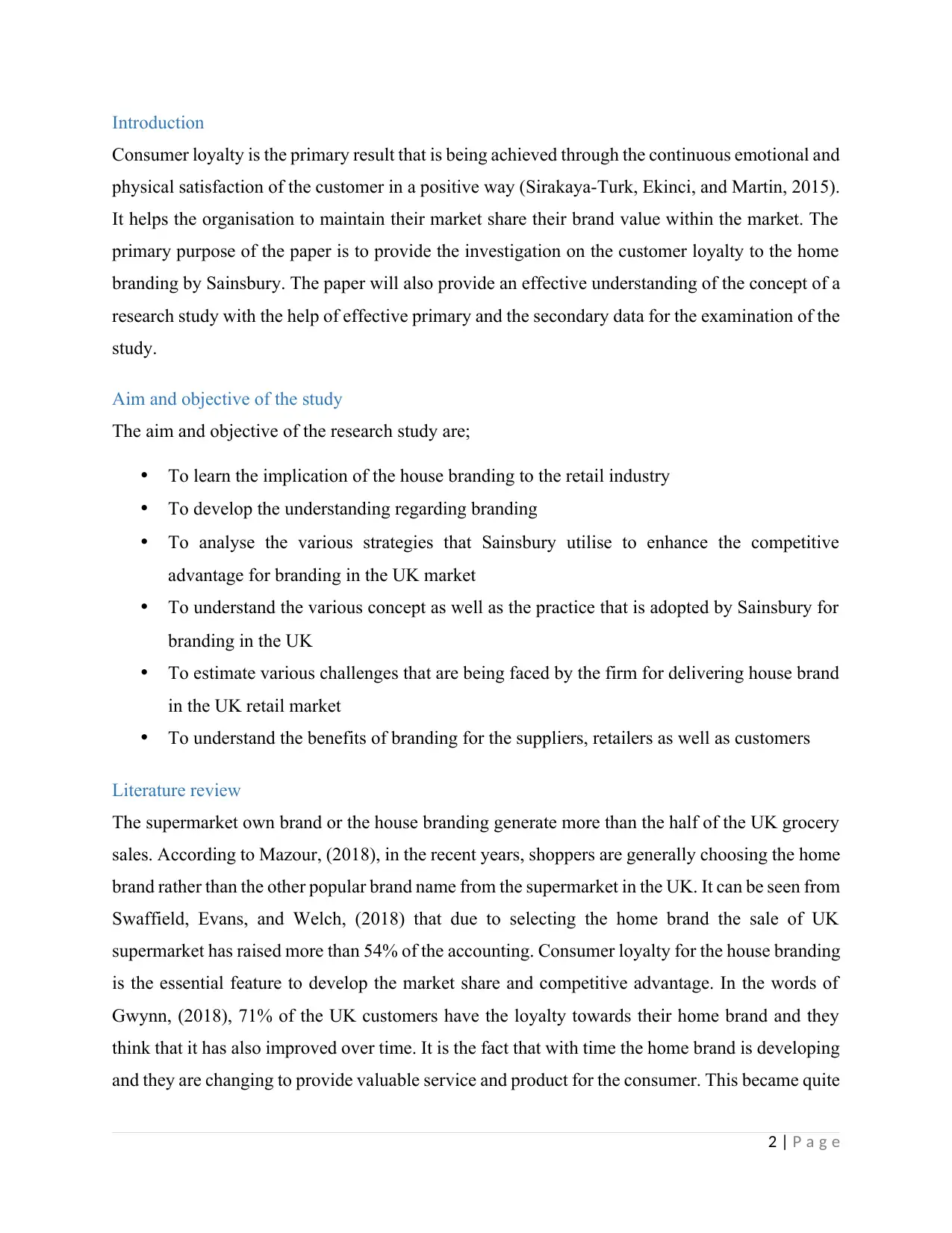
Introduction
Consumer loyalty is the primary result that is being achieved through the continuous emotional and
physical satisfaction of the customer in a positive way (Sirakaya-Turk, Ekinci, and Martin, 2015).
It helps the organisation to maintain their market share their brand value within the market. The
primary purpose of the paper is to provide the investigation on the customer loyalty to the home
branding by Sainsbury. The paper will also provide an effective understanding of the concept of a
research study with the help of effective primary and the secondary data for the examination of the
study.
Aim and objective of the study
The aim and objective of the research study are;
To learn the implication of the house branding to the retail industry
To develop the understanding regarding branding
To analyse the various strategies that Sainsbury utilise to enhance the competitive
advantage for branding in the UK market
To understand the various concept as well as the practice that is adopted by Sainsbury for
branding in the UK
To estimate various challenges that are being faced by the firm for delivering house brand
in the UK retail market
To understand the benefits of branding for the suppliers, retailers as well as customers
Literature review
The supermarket own brand or the house branding generate more than the half of the UK grocery
sales. According to Mazour, (2018), in the recent years, shoppers are generally choosing the home
brand rather than the other popular brand name from the supermarket in the UK. It can be seen from
Swaffield, Evans, and Welch, (2018) that due to selecting the home brand the sale of UK
supermarket has raised more than 54% of the accounting. Consumer loyalty for the house branding
is the essential feature to develop the market share and competitive advantage. In the words of
Gwynn, (2018), 71% of the UK customers have the loyalty towards their home brand and they
think that it has also improved over time. It is the fact that with time the home brand is developing
and they are changing to provide valuable service and product for the consumer. This became quite
2 | P a g e
Consumer loyalty is the primary result that is being achieved through the continuous emotional and
physical satisfaction of the customer in a positive way (Sirakaya-Turk, Ekinci, and Martin, 2015).
It helps the organisation to maintain their market share their brand value within the market. The
primary purpose of the paper is to provide the investigation on the customer loyalty to the home
branding by Sainsbury. The paper will also provide an effective understanding of the concept of a
research study with the help of effective primary and the secondary data for the examination of the
study.
Aim and objective of the study
The aim and objective of the research study are;
To learn the implication of the house branding to the retail industry
To develop the understanding regarding branding
To analyse the various strategies that Sainsbury utilise to enhance the competitive
advantage for branding in the UK market
To understand the various concept as well as the practice that is adopted by Sainsbury for
branding in the UK
To estimate various challenges that are being faced by the firm for delivering house brand
in the UK retail market
To understand the benefits of branding for the suppliers, retailers as well as customers
Literature review
The supermarket own brand or the house branding generate more than the half of the UK grocery
sales. According to Mazour, (2018), in the recent years, shoppers are generally choosing the home
brand rather than the other popular brand name from the supermarket in the UK. It can be seen from
Swaffield, Evans, and Welch, (2018) that due to selecting the home brand the sale of UK
supermarket has raised more than 54% of the accounting. Consumer loyalty for the house branding
is the essential feature to develop the market share and competitive advantage. In the words of
Gwynn, (2018), 71% of the UK customers have the loyalty towards their home brand and they
think that it has also improved over time. It is the fact that with time the home brand is developing
and they are changing to provide valuable service and product for the consumer. This became quite
2 | P a g e
⊘ This is a preview!⊘
Do you want full access?
Subscribe today to unlock all pages.

Trusted by 1+ million students worldwide
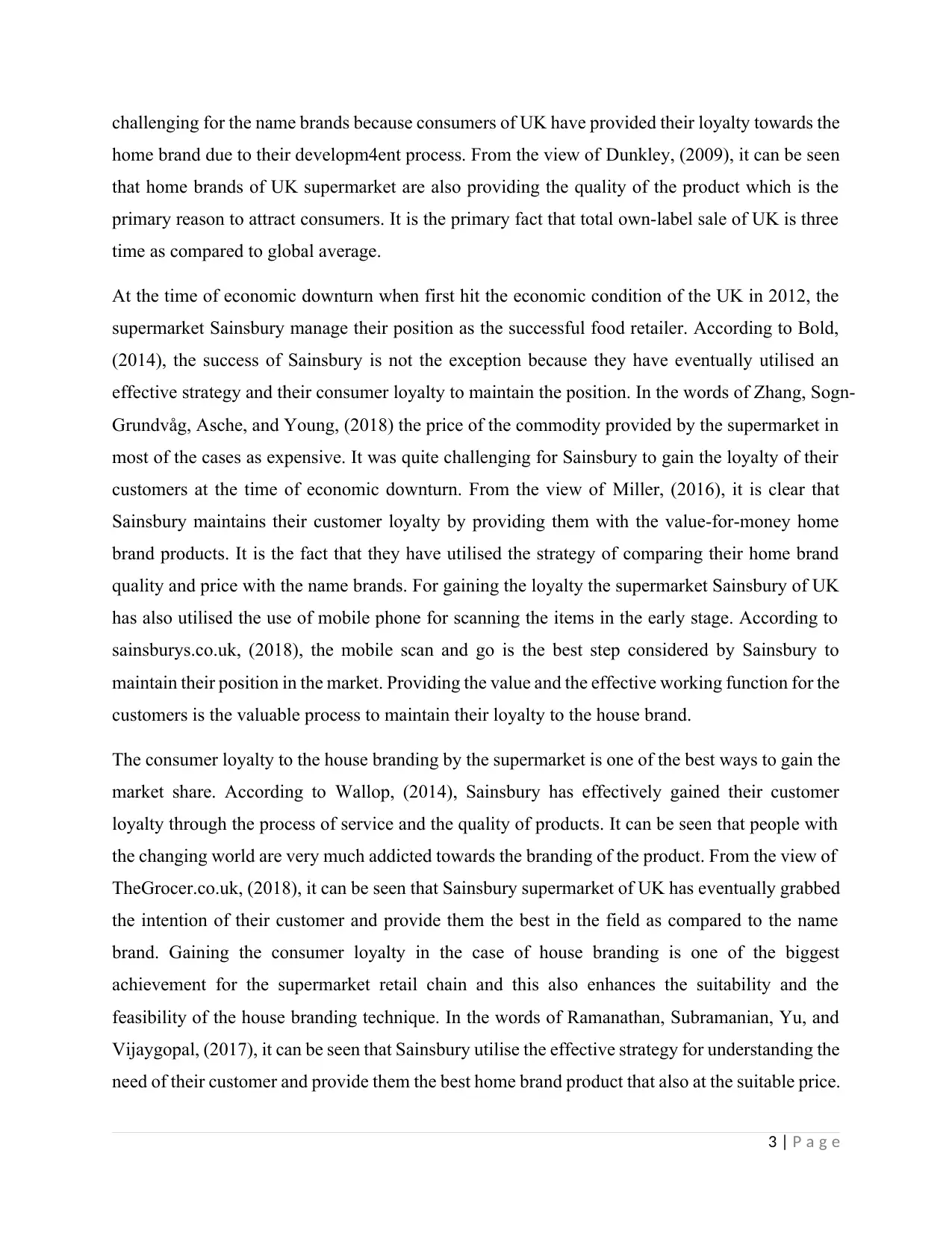
challenging for the name brands because consumers of UK have provided their loyalty towards the
home brand due to their developm4ent process. From the view of Dunkley, (2009), it can be seen
that home brands of UK supermarket are also providing the quality of the product which is the
primary reason to attract consumers. It is the primary fact that total own-label sale of UK is three
time as compared to global average.
At the time of economic downturn when first hit the economic condition of the UK in 2012, the
supermarket Sainsbury manage their position as the successful food retailer. According to Bold,
(2014), the success of Sainsbury is not the exception because they have eventually utilised an
effective strategy and their consumer loyalty to maintain the position. In the words of Zhang, Sogn-
Grundvåg, Asche, and Young, (2018) the price of the commodity provided by the supermarket in
most of the cases as expensive. It was quite challenging for Sainsbury to gain the loyalty of their
customers at the time of economic downturn. From the view of Miller, (2016), it is clear that
Sainsbury maintains their customer loyalty by providing them with the value-for-money home
brand products. It is the fact that they have utilised the strategy of comparing their home brand
quality and price with the name brands. For gaining the loyalty the supermarket Sainsbury of UK
has also utilised the use of mobile phone for scanning the items in the early stage. According to
sainsburys.co.uk, (2018), the mobile scan and go is the best step considered by Sainsbury to
maintain their position in the market. Providing the value and the effective working function for the
customers is the valuable process to maintain their loyalty to the house brand.
The consumer loyalty to the house branding by the supermarket is one of the best ways to gain the
market share. According to Wallop, (2014), Sainsbury has effectively gained their customer
loyalty through the process of service and the quality of products. It can be seen that people with
the changing world are very much addicted towards the branding of the product. From the view of
TheGrocer.co.uk, (2018), it can be seen that Sainsbury supermarket of UK has eventually grabbed
the intention of their customer and provide them the best in the field as compared to the name
brand. Gaining the consumer loyalty in the case of house branding is one of the biggest
achievement for the supermarket retail chain and this also enhances the suitability and the
feasibility of the house branding technique. In the words of Ramanathan, Subramanian, Yu, and
Vijaygopal, (2017), it can be seen that Sainsbury utilise the effective strategy for understanding the
need of their customer and provide them the best home brand product that also at the suitable price.
3 | P a g e
home brand due to their developm4ent process. From the view of Dunkley, (2009), it can be seen
that home brands of UK supermarket are also providing the quality of the product which is the
primary reason to attract consumers. It is the primary fact that total own-label sale of UK is three
time as compared to global average.
At the time of economic downturn when first hit the economic condition of the UK in 2012, the
supermarket Sainsbury manage their position as the successful food retailer. According to Bold,
(2014), the success of Sainsbury is not the exception because they have eventually utilised an
effective strategy and their consumer loyalty to maintain the position. In the words of Zhang, Sogn-
Grundvåg, Asche, and Young, (2018) the price of the commodity provided by the supermarket in
most of the cases as expensive. It was quite challenging for Sainsbury to gain the loyalty of their
customers at the time of economic downturn. From the view of Miller, (2016), it is clear that
Sainsbury maintains their customer loyalty by providing them with the value-for-money home
brand products. It is the fact that they have utilised the strategy of comparing their home brand
quality and price with the name brands. For gaining the loyalty the supermarket Sainsbury of UK
has also utilised the use of mobile phone for scanning the items in the early stage. According to
sainsburys.co.uk, (2018), the mobile scan and go is the best step considered by Sainsbury to
maintain their position in the market. Providing the value and the effective working function for the
customers is the valuable process to maintain their loyalty to the house brand.
The consumer loyalty to the house branding by the supermarket is one of the best ways to gain the
market share. According to Wallop, (2014), Sainsbury has effectively gained their customer
loyalty through the process of service and the quality of products. It can be seen that people with
the changing world are very much addicted towards the branding of the product. From the view of
TheGrocer.co.uk, (2018), it can be seen that Sainsbury supermarket of UK has eventually grabbed
the intention of their customer and provide them the best in the field as compared to the name
brand. Gaining the consumer loyalty in the case of house branding is one of the biggest
achievement for the supermarket retail chain and this also enhances the suitability and the
feasibility of the house branding technique. In the words of Ramanathan, Subramanian, Yu, and
Vijaygopal, (2017), it can be seen that Sainsbury utilise the effective strategy for understanding the
need of their customer and provide them the best home brand product that also at the suitable price.
3 | P a g e
Paraphrase This Document
Need a fresh take? Get an instant paraphrase of this document with our AI Paraphraser
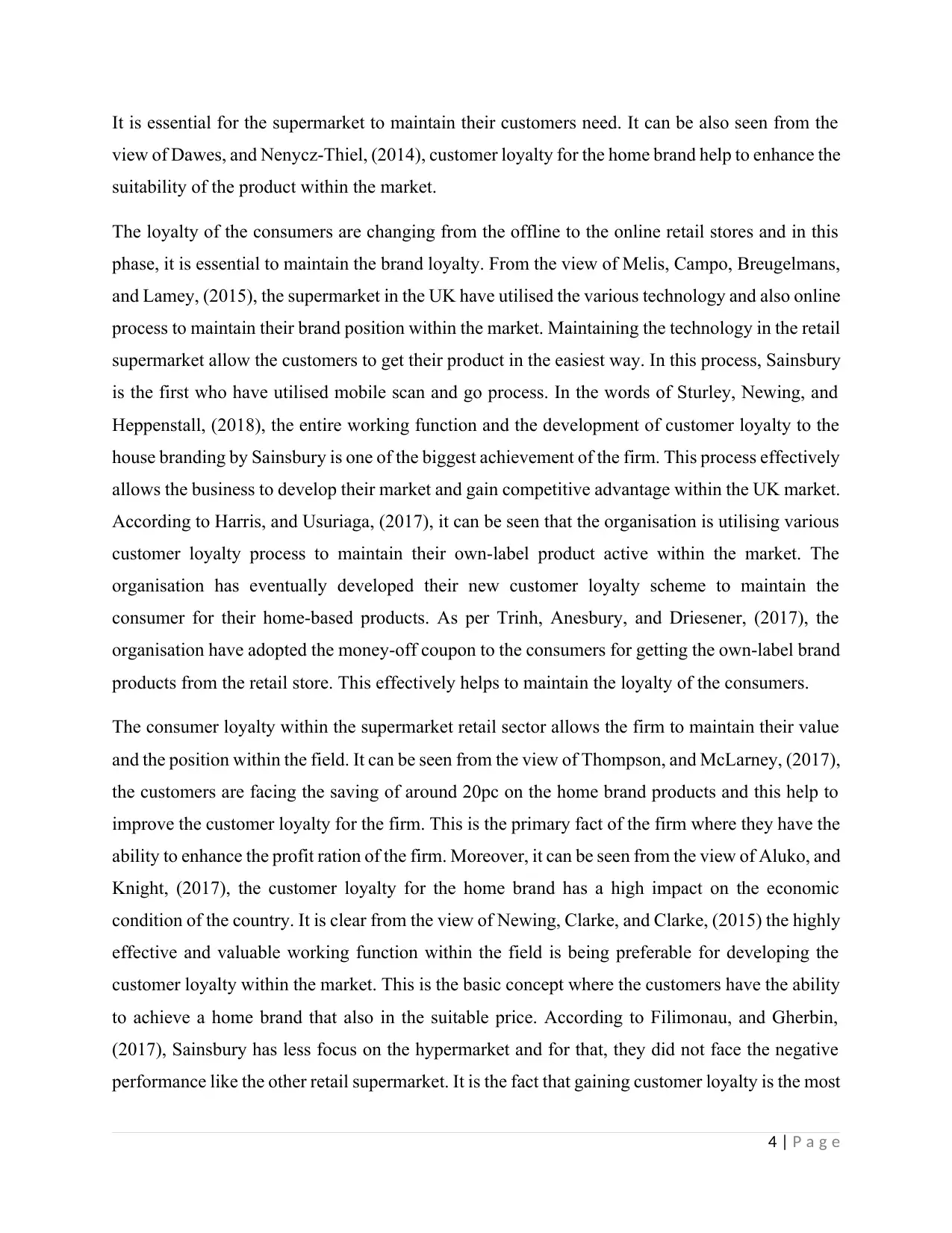
It is essential for the supermarket to maintain their customers need. It can be also seen from the
view of Dawes, and Nenycz-Thiel, (2014), customer loyalty for the home brand help to enhance the
suitability of the product within the market.
The loyalty of the consumers are changing from the offline to the online retail stores and in this
phase, it is essential to maintain the brand loyalty. From the view of Melis, Campo, Breugelmans,
and Lamey, (2015), the supermarket in the UK have utilised the various technology and also online
process to maintain their brand position within the market. Maintaining the technology in the retail
supermarket allow the customers to get their product in the easiest way. In this process, Sainsbury
is the first who have utilised mobile scan and go process. In the words of Sturley, Newing, and
Heppenstall, (2018), the entire working function and the development of customer loyalty to the
house branding by Sainsbury is one of the biggest achievement of the firm. This process effectively
allows the business to develop their market and gain competitive advantage within the UK market.
According to Harris, and Usuriaga, (2017), it can be seen that the organisation is utilising various
customer loyalty process to maintain their own-label product active within the market. The
organisation has eventually developed their new customer loyalty scheme to maintain the
consumer for their home-based products. As per Trinh, Anesbury, and Driesener, (2017), the
organisation have adopted the money-off coupon to the consumers for getting the own-label brand
products from the retail store. This effectively helps to maintain the loyalty of the consumers.
The consumer loyalty within the supermarket retail sector allows the firm to maintain their value
and the position within the field. It can be seen from the view of Thompson, and McLarney, (2017),
the customers are facing the saving of around 20pc on the home brand products and this help to
improve the customer loyalty for the firm. This is the primary fact of the firm where they have the
ability to enhance the profit ration of the firm. Moreover, it can be seen from the view of Aluko, and
Knight, (2017), the customer loyalty for the home brand has a high impact on the economic
condition of the country. It is clear from the view of Newing, Clarke, and Clarke, (2015) the highly
effective and valuable working function within the field is being preferable for developing the
customer loyalty within the market. This is the basic concept where the customers have the ability
to achieve a home brand that also in the suitable price. According to Filimonau, and Gherbin,
(2017), Sainsbury has less focus on the hypermarket and for that, they did not face the negative
performance like the other retail supermarket. It is the fact that gaining customer loyalty is the most
4 | P a g e
view of Dawes, and Nenycz-Thiel, (2014), customer loyalty for the home brand help to enhance the
suitability of the product within the market.
The loyalty of the consumers are changing from the offline to the online retail stores and in this
phase, it is essential to maintain the brand loyalty. From the view of Melis, Campo, Breugelmans,
and Lamey, (2015), the supermarket in the UK have utilised the various technology and also online
process to maintain their brand position within the market. Maintaining the technology in the retail
supermarket allow the customers to get their product in the easiest way. In this process, Sainsbury
is the first who have utilised mobile scan and go process. In the words of Sturley, Newing, and
Heppenstall, (2018), the entire working function and the development of customer loyalty to the
house branding by Sainsbury is one of the biggest achievement of the firm. This process effectively
allows the business to develop their market and gain competitive advantage within the UK market.
According to Harris, and Usuriaga, (2017), it can be seen that the organisation is utilising various
customer loyalty process to maintain their own-label product active within the market. The
organisation has eventually developed their new customer loyalty scheme to maintain the
consumer for their home-based products. As per Trinh, Anesbury, and Driesener, (2017), the
organisation have adopted the money-off coupon to the consumers for getting the own-label brand
products from the retail store. This effectively helps to maintain the loyalty of the consumers.
The consumer loyalty within the supermarket retail sector allows the firm to maintain their value
and the position within the field. It can be seen from the view of Thompson, and McLarney, (2017),
the customers are facing the saving of around 20pc on the home brand products and this help to
improve the customer loyalty for the firm. This is the primary fact of the firm where they have the
ability to enhance the profit ration of the firm. Moreover, it can be seen from the view of Aluko, and
Knight, (2017), the customer loyalty for the home brand has a high impact on the economic
condition of the country. It is clear from the view of Newing, Clarke, and Clarke, (2015) the highly
effective and valuable working function within the field is being preferable for developing the
customer loyalty within the market. This is the basic concept where the customers have the ability
to achieve a home brand that also in the suitable price. According to Filimonau, and Gherbin,
(2017), Sainsbury has less focus on the hypermarket and for that, they did not face the negative
performance like the other retail supermarket. It is the fact that gaining customer loyalty is the most
4 | P a g e
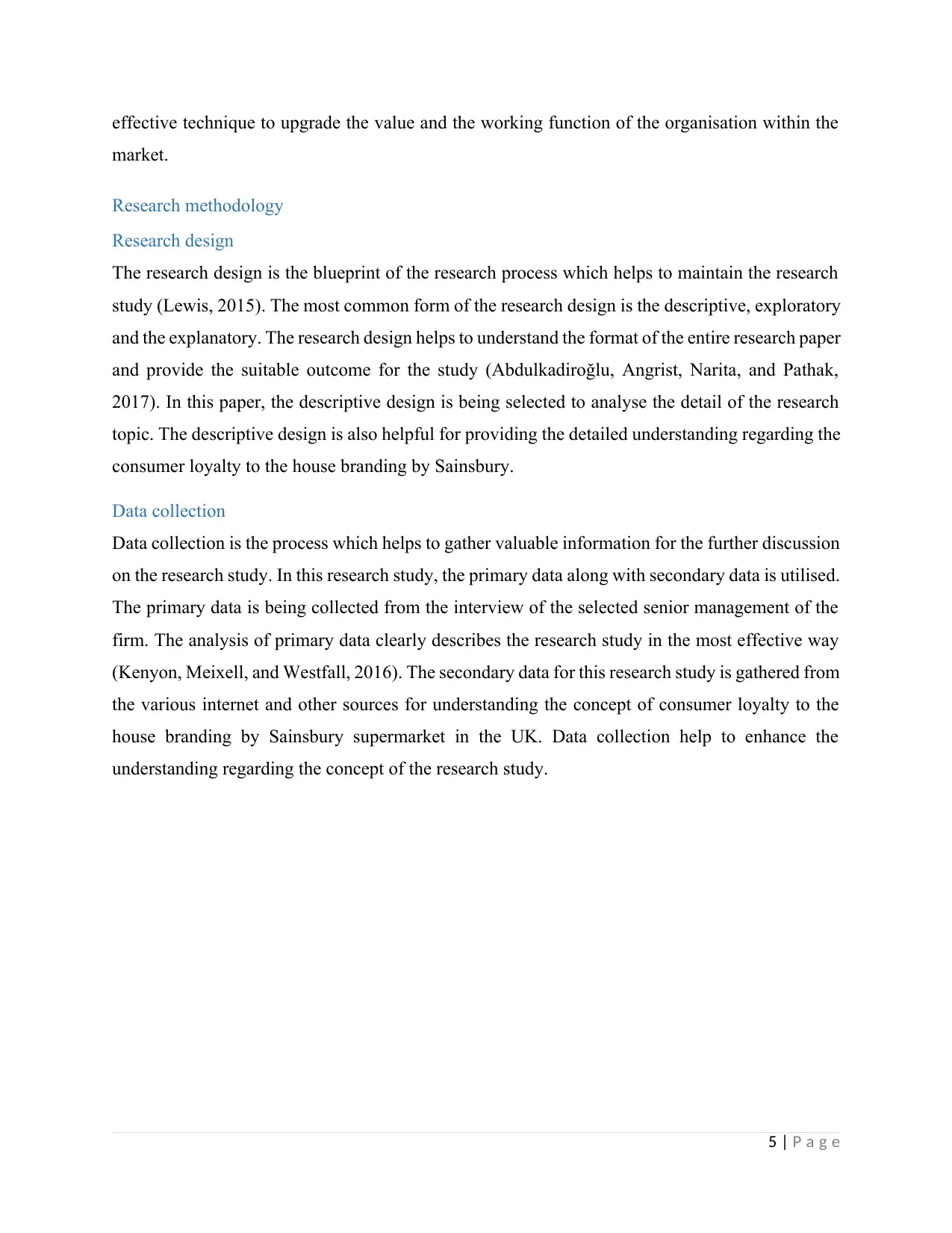
effective technique to upgrade the value and the working function of the organisation within the
market.
Research methodology
Research design
The research design is the blueprint of the research process which helps to maintain the research
study (Lewis, 2015). The most common form of the research design is the descriptive, exploratory
and the explanatory. The research design helps to understand the format of the entire research paper
and provide the suitable outcome for the study (Abdulkadiroğlu, Angrist, Narita, and Pathak,
2017). In this paper, the descriptive design is being selected to analyse the detail of the research
topic. The descriptive design is also helpful for providing the detailed understanding regarding the
consumer loyalty to the house branding by Sainsbury.
Data collection
Data collection is the process which helps to gather valuable information for the further discussion
on the research study. In this research study, the primary data along with secondary data is utilised.
The primary data is being collected from the interview of the selected senior management of the
firm. The analysis of primary data clearly describes the research study in the most effective way
(Kenyon, Meixell, and Westfall, 2016). The secondary data for this research study is gathered from
the various internet and other sources for understanding the concept of consumer loyalty to the
house branding by Sainsbury supermarket in the UK. Data collection help to enhance the
understanding regarding the concept of the research study.
5 | P a g e
market.
Research methodology
Research design
The research design is the blueprint of the research process which helps to maintain the research
study (Lewis, 2015). The most common form of the research design is the descriptive, exploratory
and the explanatory. The research design helps to understand the format of the entire research paper
and provide the suitable outcome for the study (Abdulkadiroğlu, Angrist, Narita, and Pathak,
2017). In this paper, the descriptive design is being selected to analyse the detail of the research
topic. The descriptive design is also helpful for providing the detailed understanding regarding the
consumer loyalty to the house branding by Sainsbury.
Data collection
Data collection is the process which helps to gather valuable information for the further discussion
on the research study. In this research study, the primary data along with secondary data is utilised.
The primary data is being collected from the interview of the selected senior management of the
firm. The analysis of primary data clearly describes the research study in the most effective way
(Kenyon, Meixell, and Westfall, 2016). The secondary data for this research study is gathered from
the various internet and other sources for understanding the concept of consumer loyalty to the
house branding by Sainsbury supermarket in the UK. Data collection help to enhance the
understanding regarding the concept of the research study.
5 | P a g e
⊘ This is a preview!⊘
Do you want full access?
Subscribe today to unlock all pages.

Trusted by 1+ million students worldwide
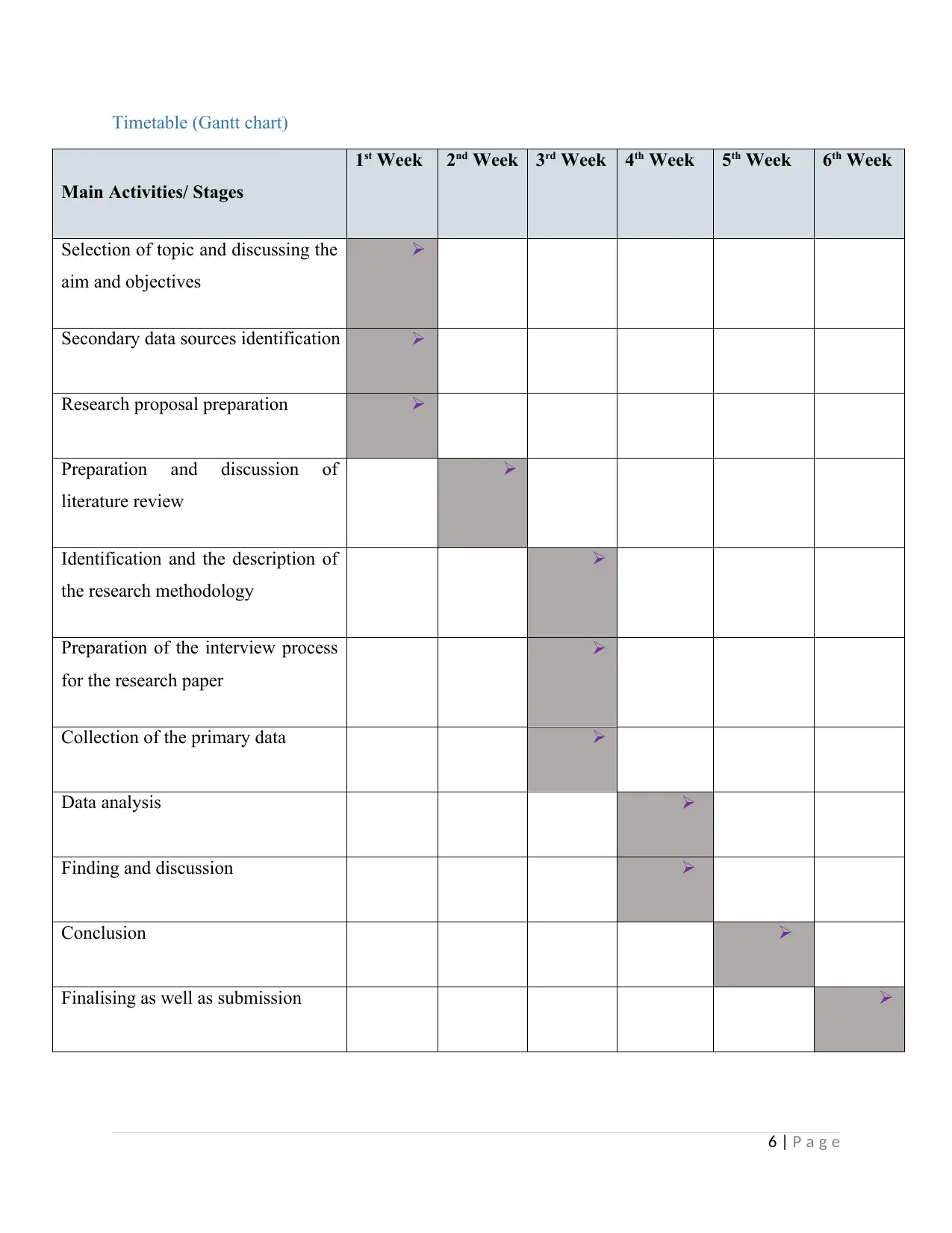
Timetable (Gantt chart)
6 | P a g e
Main Activities/ Stages
1st Week 2nd Week 3rd Week 4th Week 5th Week 6th Week
Selection of topic and discussing the
aim and objectives
Secondary data sources identification
Research proposal preparation
Preparation and discussion of
literature review
Identification and the description of
the research methodology
Preparation of the interview process
for the research paper
Collection of the primary data
Data analysis
Finding and discussion
Conclusion
Finalising as well as submission
6 | P a g e
Main Activities/ Stages
1st Week 2nd Week 3rd Week 4th Week 5th Week 6th Week
Selection of topic and discussing the
aim and objectives
Secondary data sources identification
Research proposal preparation
Preparation and discussion of
literature review
Identification and the description of
the research methodology
Preparation of the interview process
for the research paper
Collection of the primary data
Data analysis
Finding and discussion
Conclusion
Finalising as well as submission
Paraphrase This Document
Need a fresh take? Get an instant paraphrase of this document with our AI Paraphraser

7 | P a g e
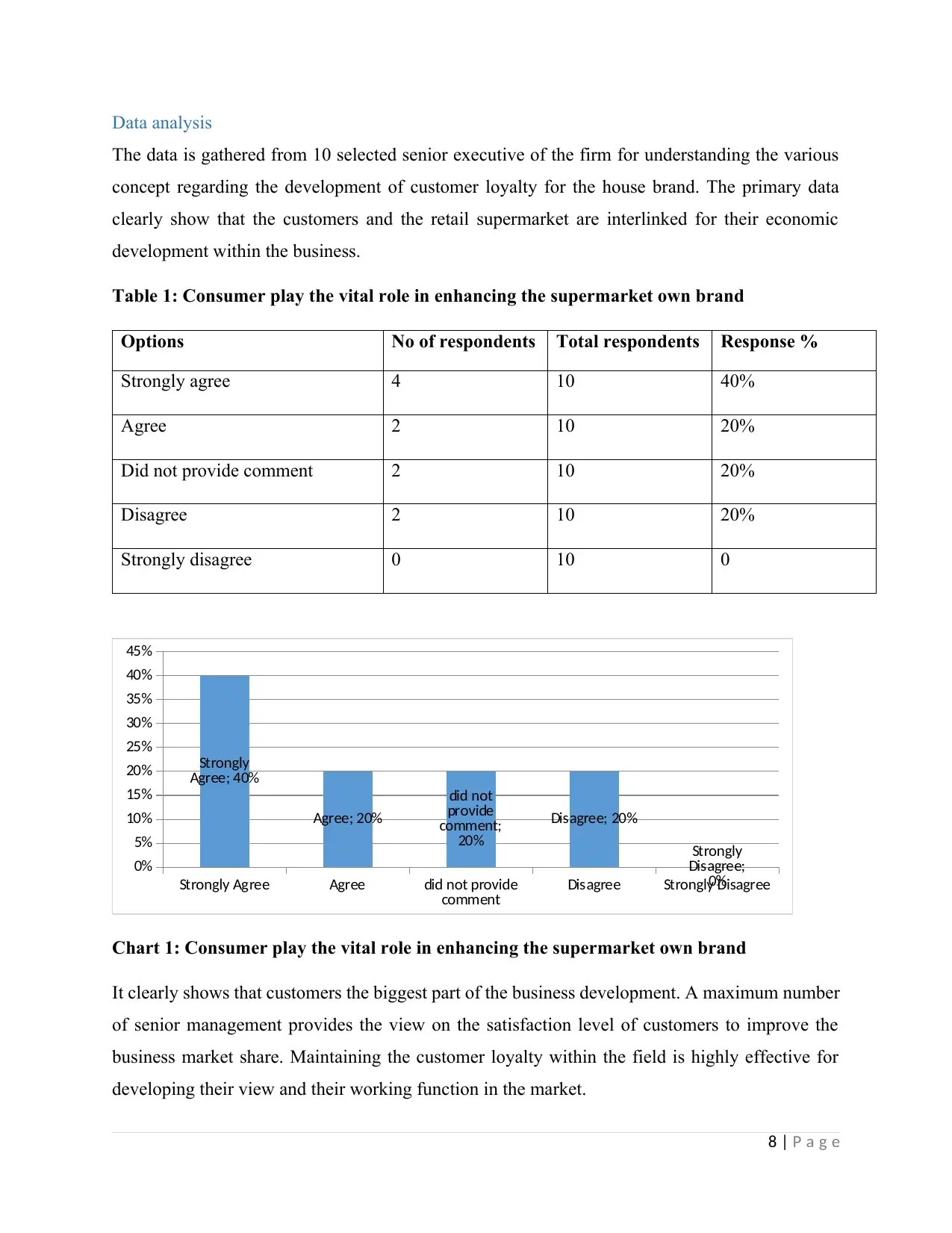
Data analysis
The data is gathered from 10 selected senior executive of the firm for understanding the various
concept regarding the development of customer loyalty for the house brand. The primary data
clearly show that the customers and the retail supermarket are interlinked for their economic
development within the business.
Table 1: Consumer play the vital role in enhancing the supermarket own brand
Options No of respondents Total respondents Response %
Strongly agree 4 10 40%
Agree 2 10 20%
Did not provide comment 2 10 20%
Disagree 2 10 20%
Strongly disagree 0 10 0
Strongly Agree Agree did not provide
comment Disagree Strongly Disagree
0%
5%
10%
15%
20%
25%
30%
35%
40%
45%
Strongly
Agree; 40%
Agree; 20%
did not
provide
comment;
20%
Disagree; 20%
Strongly
Disagree;
0%
Chart 1: Consumer play the vital role in enhancing the supermarket own brand
It clearly shows that customers the biggest part of the business development. A maximum number
of senior management provides the view on the satisfaction level of customers to improve the
business market share. Maintaining the customer loyalty within the field is highly effective for
developing their view and their working function in the market.
8 | P a g e
The data is gathered from 10 selected senior executive of the firm for understanding the various
concept regarding the development of customer loyalty for the house brand. The primary data
clearly show that the customers and the retail supermarket are interlinked for their economic
development within the business.
Table 1: Consumer play the vital role in enhancing the supermarket own brand
Options No of respondents Total respondents Response %
Strongly agree 4 10 40%
Agree 2 10 20%
Did not provide comment 2 10 20%
Disagree 2 10 20%
Strongly disagree 0 10 0
Strongly Agree Agree did not provide
comment Disagree Strongly Disagree
0%
5%
10%
15%
20%
25%
30%
35%
40%
45%
Strongly
Agree; 40%
Agree; 20%
did not
provide
comment;
20%
Disagree; 20%
Strongly
Disagree;
0%
Chart 1: Consumer play the vital role in enhancing the supermarket own brand
It clearly shows that customers the biggest part of the business development. A maximum number
of senior management provides the view on the satisfaction level of customers to improve the
business market share. Maintaining the customer loyalty within the field is highly effective for
developing their view and their working function in the market.
8 | P a g e
⊘ This is a preview!⊘
Do you want full access?
Subscribe today to unlock all pages.

Trusted by 1+ million students worldwide
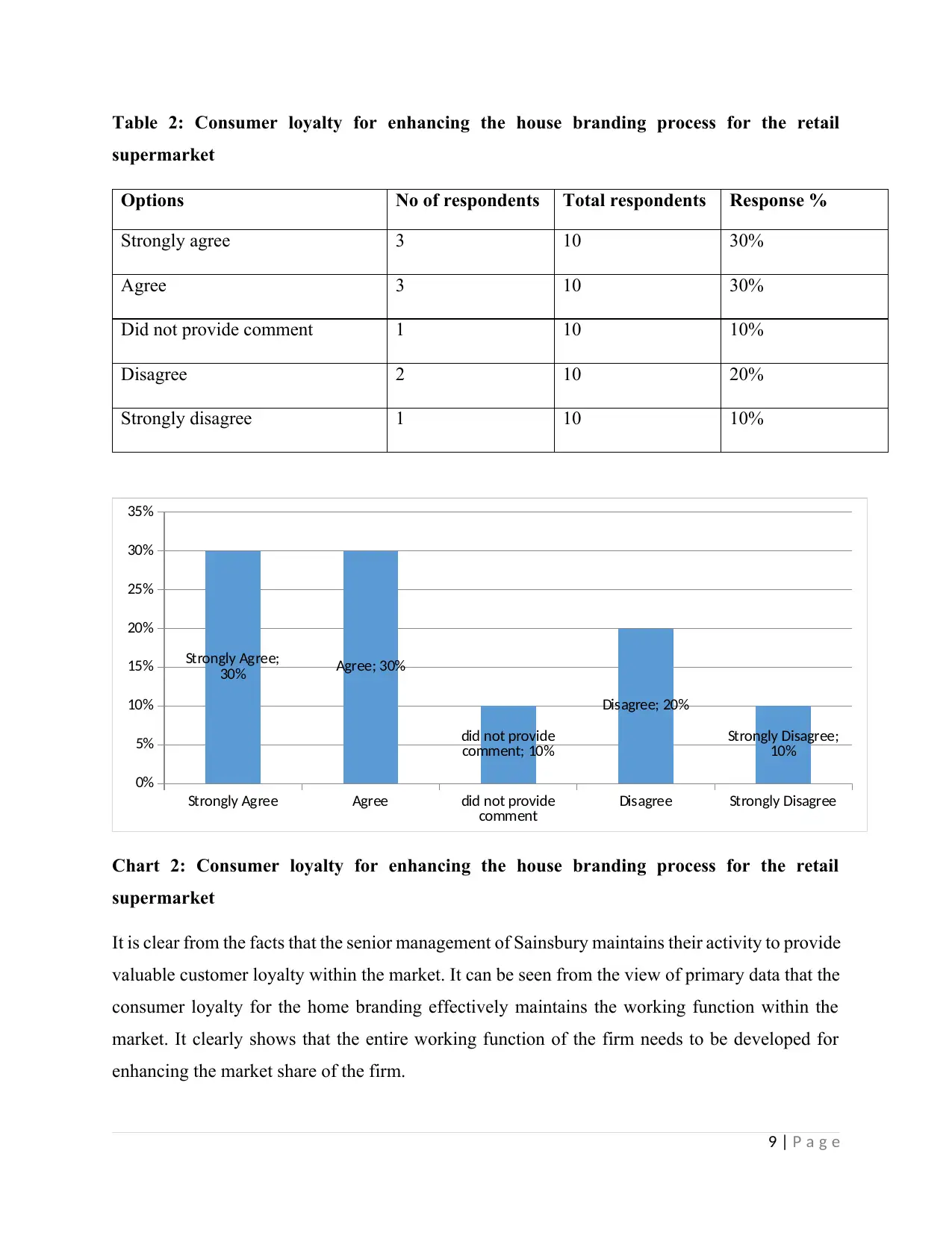
Table 2: Consumer loyalty for enhancing the house branding process for the retail
supermarket
Options No of respondents Total respondents Response %
Strongly agree 3 10 30%
Agree 3 10 30%
Did not provide comment 1 10 10%
Disagree 2 10 20%
Strongly disagree 1 10 10%
Strongly Agree Agree did not provide
comment Disagree Strongly Disagree
0%
5%
10%
15%
20%
25%
30%
35%
Strongly Agree;
30% Agree; 30%
did not provide
comment; 10%
Disagree; 20%
Strongly Disagree;
10%
Chart 2: Consumer loyalty for enhancing the house branding process for the retail
supermarket
It is clear from the facts that the senior management of Sainsbury maintains their activity to provide
valuable customer loyalty within the market. It can be seen from the view of primary data that the
consumer loyalty for the home branding effectively maintains the working function within the
market. It clearly shows that the entire working function of the firm needs to be developed for
enhancing the market share of the firm.
9 | P a g e
supermarket
Options No of respondents Total respondents Response %
Strongly agree 3 10 30%
Agree 3 10 30%
Did not provide comment 1 10 10%
Disagree 2 10 20%
Strongly disagree 1 10 10%
Strongly Agree Agree did not provide
comment Disagree Strongly Disagree
0%
5%
10%
15%
20%
25%
30%
35%
Strongly Agree;
30% Agree; 30%
did not provide
comment; 10%
Disagree; 20%
Strongly Disagree;
10%
Chart 2: Consumer loyalty for enhancing the house branding process for the retail
supermarket
It is clear from the facts that the senior management of Sainsbury maintains their activity to provide
valuable customer loyalty within the market. It can be seen from the view of primary data that the
consumer loyalty for the home branding effectively maintains the working function within the
market. It clearly shows that the entire working function of the firm needs to be developed for
enhancing the market share of the firm.
9 | P a g e
Paraphrase This Document
Need a fresh take? Get an instant paraphrase of this document with our AI Paraphraser
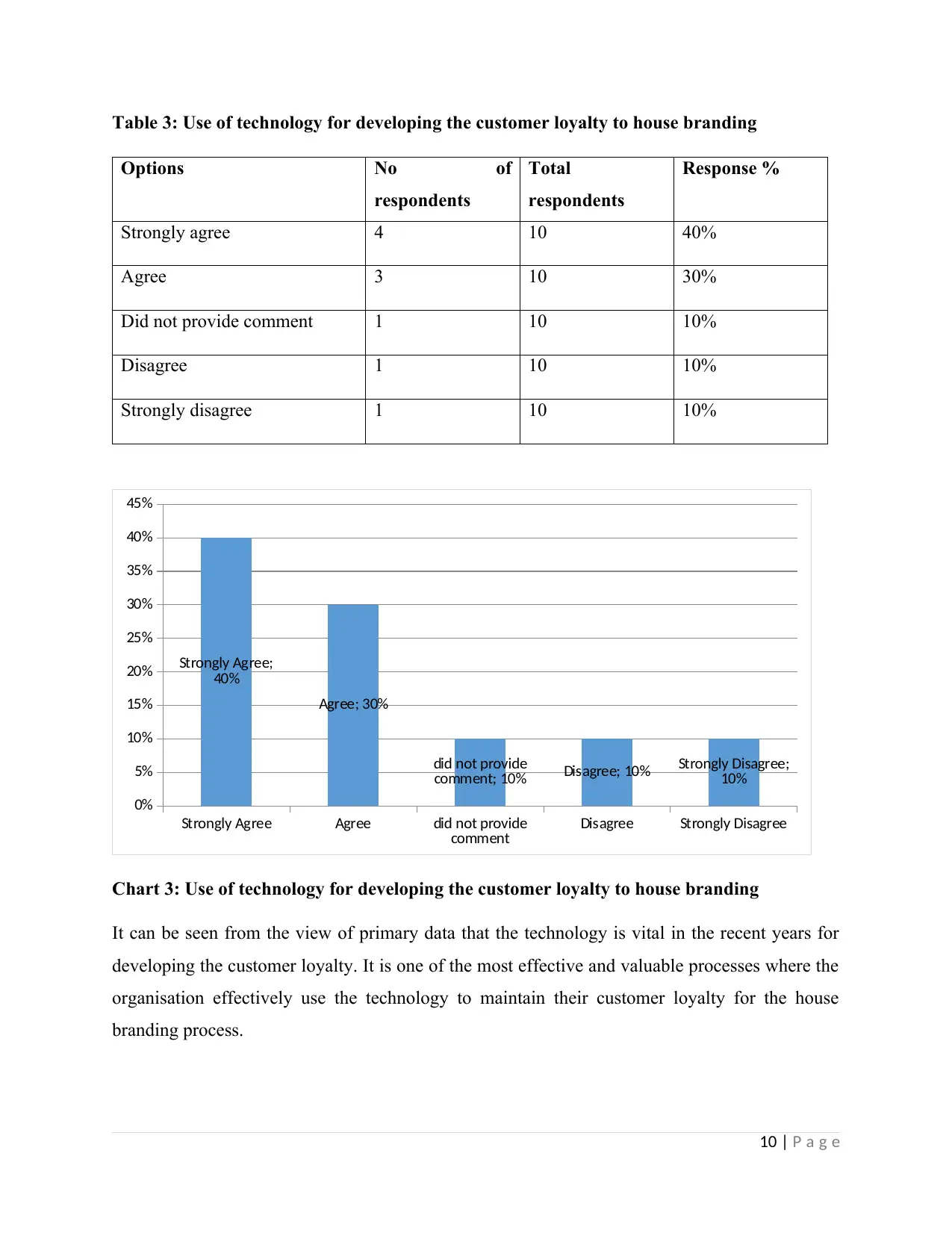
Table 3: Use of technology for developing the customer loyalty to house branding
Options No of
respondents
Total
respondents
Response %
Strongly agree 4 10 40%
Agree 3 10 30%
Did not provide comment 1 10 10%
Disagree 1 10 10%
Strongly disagree 1 10 10%
Strongly Agree Agree did not provide
comment Disagree Strongly Disagree
0%
5%
10%
15%
20%
25%
30%
35%
40%
45%
Strongly Agree;
40%
Agree; 30%
did not provide
comment; 10% Disagree; 10% Strongly Disagree;
10%
Chart 3: Use of technology for developing the customer loyalty to house branding
It can be seen from the view of primary data that the technology is vital in the recent years for
developing the customer loyalty. It is one of the most effective and valuable processes where the
organisation effectively use the technology to maintain their customer loyalty for the house
branding process.
10 | P a g e
Options No of
respondents
Total
respondents
Response %
Strongly agree 4 10 40%
Agree 3 10 30%
Did not provide comment 1 10 10%
Disagree 1 10 10%
Strongly disagree 1 10 10%
Strongly Agree Agree did not provide
comment Disagree Strongly Disagree
0%
5%
10%
15%
20%
25%
30%
35%
40%
45%
Strongly Agree;
40%
Agree; 30%
did not provide
comment; 10% Disagree; 10% Strongly Disagree;
10%
Chart 3: Use of technology for developing the customer loyalty to house branding
It can be seen from the view of primary data that the technology is vital in the recent years for
developing the customer loyalty. It is one of the most effective and valuable processes where the
organisation effectively use the technology to maintain their customer loyalty for the house
branding process.
10 | P a g e
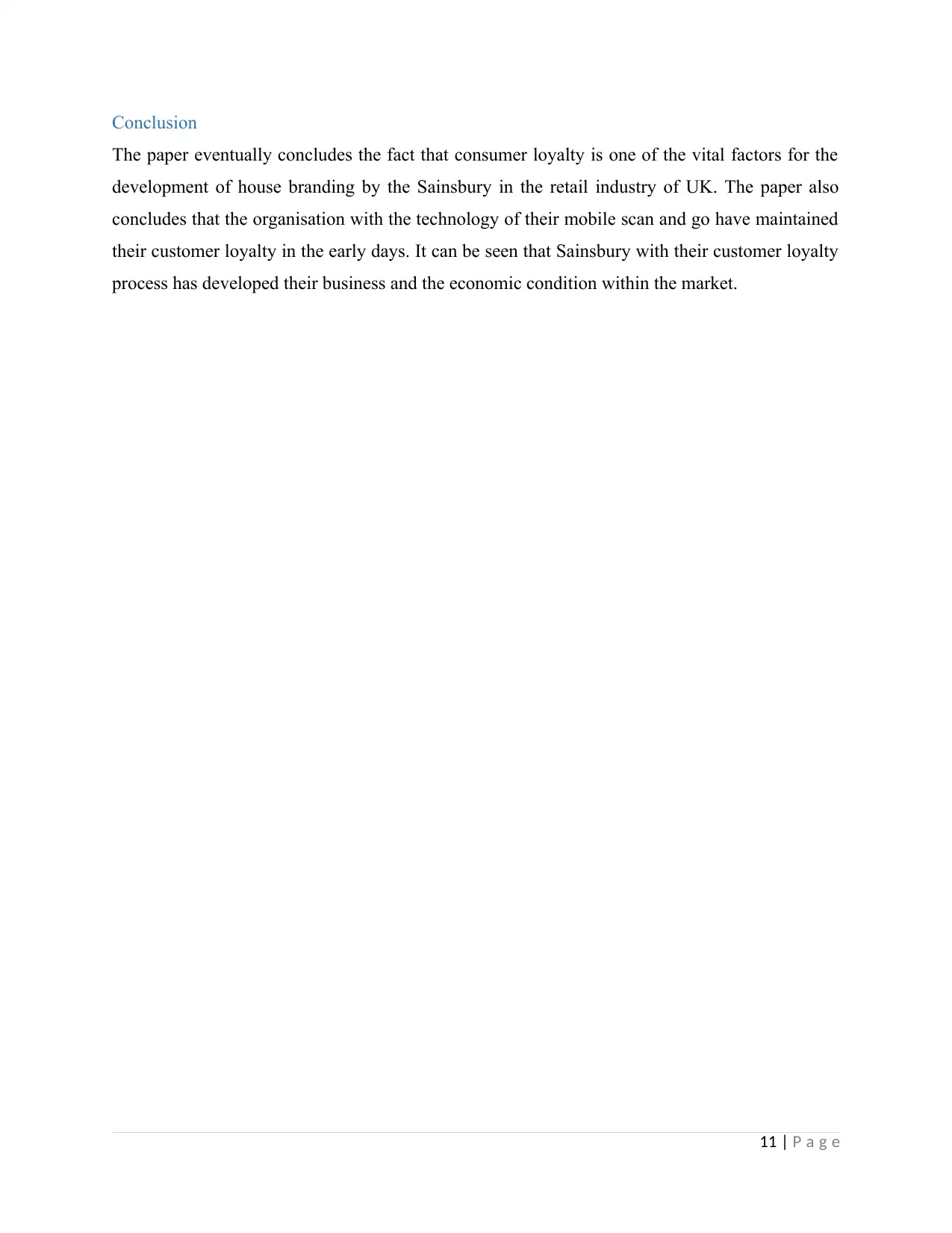
Conclusion
The paper eventually concludes the fact that consumer loyalty is one of the vital factors for the
development of house branding by the Sainsbury in the retail industry of UK. The paper also
concludes that the organisation with the technology of their mobile scan and go have maintained
their customer loyalty in the early days. It can be seen that Sainsbury with their customer loyalty
process has developed their business and the economic condition within the market.
11 | P a g e
The paper eventually concludes the fact that consumer loyalty is one of the vital factors for the
development of house branding by the Sainsbury in the retail industry of UK. The paper also
concludes that the organisation with the technology of their mobile scan and go have maintained
their customer loyalty in the early days. It can be seen that Sainsbury with their customer loyalty
process has developed their business and the economic condition within the market.
11 | P a g e
⊘ This is a preview!⊘
Do you want full access?
Subscribe today to unlock all pages.

Trusted by 1+ million students worldwide
1 out of 15
Related Documents
Your All-in-One AI-Powered Toolkit for Academic Success.
+13062052269
info@desklib.com
Available 24*7 on WhatsApp / Email
![[object Object]](/_next/static/media/star-bottom.7253800d.svg)
Unlock your academic potential
Copyright © 2020–2025 A2Z Services. All Rights Reserved. Developed and managed by ZUCOL.





